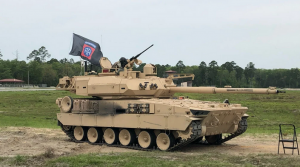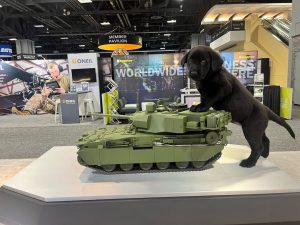The Army’s new light tank can venture where its beefier cousins can’t
BY PGF
The Army awarded General Dynamics Land Systems a contract for its Mobile Protected Firepower light tank. (US Army photo)
Popular Science: Via Instapundit.
When it comes to crossing rivers on bridges, all the technology of modern warfare is still bound by the hard limits imposed by the laws of physics—the structure needs to be able to support the vehicle that’s on it. To try to cope with this problem, the Army is investing in a lighter tank than its current battlefield behemoth, the M1 Abrams main battle tank. This new vehicle, which is still known by its descriptive moniker Mobile Protected Firepower, was promoted at the Association of the United States Army conference held in Washington, DC, from October 10-12.
The Mobile Protected Firepower (MPF) vehicle weighs in at 38 tons, which is heavy by all standards, except it is light compared to the 70 tons of heft of an Abrams tank. That means it can go places the Abrams can’t, expanding how and where the Army can effectively fight war from vehicles. The MPF will also feature fire control and situational awareness sensors, which can allow enemy location data to be shared across vehicles in formation.
The MPF is designed to accompany Infantry Brigade Combat Teams, which are intended primarily for travel on foot. These formations, which consist of between 3,900 to 4,100 people, incorporate some vehicles, but are distinguished from Armored and Stryker Brigade Combat Teams, which use roughly heavy and medium-armored vehicles to transport soldiers and weapons around the battlefield.
Breaking Defense: (from June)
The Mobile Protected Firepower program is part of the Army’s Next-Generation Combat Vehicle portfolio, which is developing future ground vehicles as part of the services’ broader, multi-billion modernization effort that includes the Optionally Manned Fighting Vehicle.
Optionally Manned Fighting (ground) Vehicles and Unmanned Fighting (ground) Vehicles can now be added to the vernacular that includes UAVs.
The Army’s stated acquisition objective for the program is 504 vehicles. The first production vehicle will be delivered in “just under” 19 months, Dean said, a timetable that roughly hits around December 2023. That timeline is driven in part by the time it takes to get long-lead time parts, Dean said.
Moving into production, the Army and GDLS will have to be diligent to avoid supply chain issues as production ramps up. Dean said the program was already experiencing “challenges” in the supply base.
“We are seeing challenges in the supply base right now both in cost and availability [of] materials, as well as competition for other components, particularly in the electronic space where electronic chips are in big demand,” Dean said, adding the Army had “some comfort” because the proposals had “reasonable control” over their supply chain.
So, General Dynamics can’t get raw materials and parts; why? Aren’t these sourced entirely in the US? Building fighting machines based on a global JIT supply chain seems fairly idiotic. If there’s an actual war, not one of those banker’s wars, mind you, but a real war, how can the United States satisfy its national strategic interests if it can’t build fighting machines and field trained fighting men? America does not appear to be a serious power anymore. The best part of the top photo is the little step stool. Is that for Generals to look down the barrel?
Here’s a scale model from AUSA‘s recent trade show and exhibition:

Also, at the show – (Why do we get the feeling many of these will be used in CONUS?)
AbramsX:

TRX Breacher:

StrykerX:

Stryker Leonidas:

Better Photo of the Leonidas:






On October 16, 2022 at 8:06 pm, Herschel Smith said:
Just like serious ship-building. Raw materials, and the ability to do large scale manufacturing, castings, forgings, welding, etc., left the U.S. a very long time ago and headed to Japan and China.
Here’s a factoid for you. The reactor vessels for Catawba Nuclear Station were made in the Rotterdam shipyard. Not the U.S.
On October 16, 2022 at 9:33 pm, Michael Gilson said:
According to what I’ve read, while looking like a tank the MPF is more like an assault gun with a role similar to the separate tank battalions of WW2. One of the reasons for the tank look is to use the same fire control systems as Abrams to simplify training.
On October 16, 2022 at 11:40 pm, Dan said:
US industry has outsourced virtually EVERYTHING to other countries over the past couple of decades. Doing so means MORE PROFITS for the companies. They simply aren’t interested in anything else.
On October 17, 2022 at 7:10 am, Bill Buppert said:
The era of manned tanks is over; this is much like the naval fixation with battleships before 1941 around the globe and then, all of a sudden, not feasible for winning the strategic and operational fight; battleships and other large capital ships became little more than ordnance sponges.
Fast forward to now: missile sponges.
Same for infantry fighting vehicles like the horrifically designed and overweight Bradley IFV.
Iraq: In 2006, total losses included 55 Bradleys destroyed and some 700 others damaged. By the end of the war, about 150 Bradleys had been destroyed.
The Army has been trying to replace the POS since the 1990’s.
On October 17, 2022 at 8:52 am, PGF said:
Unrefined thoughts on the “End of Armor,” re, Mr. Buppert’s comment. We heard in Chasing Ghosts ep 2 [ https://rss.com/podcasts/cgp/650885/ ] that you mentioned the end of the usefulness of Navel Carriers and Modern Tanks.
Several things come to mind with the US push toward unmanned ground vehicles. First, the US is not above spending a billion dollars for what amounts to a battlefield sensor with a gun. In irregular warfare, if nobody is inside the vehicle, attacking it only serves to give away an insurgent’s position to other US ground and airborne assets. Ignoring unmanned vehicles would seem prudent, especially in a dirty war, where insurgents have jobs and normal daily activities while also fighting, essentially living dual lives.
Also, these ground vehicles can’t get far without fuel. Attacking the people who send them, or more likely the fuel source(s), seems the most prudent. With the push to EV civilian transportation, Oil based fuel transport and storage locations will begin to be less ubiquitous, therefor the ones that remain will stand out. (If EVs were practical the Department of Defense would be leading no lagging or rejecting the idea!)
The era of armor in practical application may be over, but they still exist, and the primary concern for someone fighting the US is that interconnected sensor capability, it would seem.
On October 17, 2022 at 11:01 am, Drake said:
They’ve been looking for a light-tank since they retired the Sheridan and left the 82nd Airborne without an Armor battalion. First it was a gun version of the LAV, then a Stryker Mobile Gun System, now this. It’s like that absurd new rifle – a hole to throw money in that will never make to the field.
On October 17, 2022 at 1:10 pm, Biff said:
How many millions for each? They cost so much that we can’t afford to lose any. Like that disaster of the Marines new landing craft. Gee, you’d think that these things are just for the Mil industrial complex to profit. But nah, that can’t be!?
On October 17, 2022 at 6:19 pm, john s allison said:
I’ll wait to see them operating operationally in actual units. Lots of stuff that gets displayed at AUSA conventions never see the light of day afterwards.
On October 20, 2022 at 3:33 am, Aesop said:
What Drake said.
The Sheridan was a total POS from the get-go, suitable only for fake VISMOD Soviet aggressor training at the NTC. For anything else, it was a joke.
But the 82d and the Marines will always need a lighter-than-the-monstrous-Abrams tank/assault gun, and the answer should have been putting a 90mm turret on a LAV-25 for both organizations.
But not enough pork for the barrel, so it always died stillborn.
Unless they lard this one up, it too will die a quick and unlamented death.